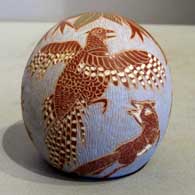Camilio Sunflower Tafoya
Santa Clara
Camilio Tafoya was born in 1902 to Geronimo and Sarafina Tafoya of Santa Clara Pueblo. Like his sisters, Margaret Tafoya and Christina Naranjo, he grew up watching and helping his mother make pottery. His father, a wood carver, taught him to carve and Camilio adapted that learning to the carving of pottery. He learned to make his clay coils thicker and allow the pots to dry harder before beginning to carve them. That solved the problem of carving too deeply and ruining a pot by carving through it. Using his method he learned to make very large carved jars.
Among his favorite designs to carve were the avanyu (water serpent), birds, flowers, bear paws, and ancient Mimbres and rock art designs he found while hiking around in the hills and mountains surrounding Santa Clara. Joseph, Camilio's son, remembered his father taking him into the mountains and hiking around. Joseph was impressed by the petroglyphs they often came across. Camilio was able to translate the meanings of many of the designs so that Joseph could understand what the designs symbolized. Variations of those carved designs reappeared many times over the years in the work of Camilio and later in Joseph's work. During those walks they also found many old pottery shards, some painted, some incised, some carved, some corrugated and all ancient. That's where the great storehouse of Santa Clara designs is kept.
Camilio was one of the first men to become known as a potter in the pueblo. Many men helped their wives with different aspects of the process, like digging and processing the clay, scraping/sanding pots, gathering firewood and manure, firing the pots, etc., but Camilio did the whole process from end to end. His wife, Agapita (Silva) (1904-1959), was an accomplished potter when they married and they worked together for many years. Camilio and Agapita taught their son, Joseph Lonewolf, and daughters Grace Medicine Flower and Lucy Year Flower how to make pottery.
In the 1960s, after his wife passed, Camilio stopped making his large, carved pots and his famous sculptural horses. Instead, he, Joseph and Grace began developing the fine art of meticulously incising pottery now known as sgraffito. In that method, designs are scratched into the hard-dried surface of a pot before (or after) firing. Simple mistakes can ruin a pot. The amount of time and degree of meticulous work involved have made for increased prices for sgraffito-decorated pots.
In late 1968 Camilio began working closely with Grace, making many highly polished black and red seedpots decorated with intricate sgraffito work. In 1972 he went to work at Joseph's house and was busy making exceptional sgraffito art there almost until the day he died.
In 1985, along with his sister Margaret Tafoya and 42 other Santa Clara potters, Camilio participated in a show at the Sid Deusch Gallery in New York City. He also participated in several gallery shows with his son Joseph in Sacramento and Santa Monica, California and in Santa Fe, New Mexico.
Camilio was well-known for having a great sense of humor. One summer in the early 1990s Joseph was preparing for a show at Andrea Fisher Fine Pottery in Santa Fe. Andrea says Camilio came in to see what was happening, said hello to everyone, sat down and joined in the conversation. Someone asked if he had new boots on (because Camilio always wore fancy cowboy boots). He looked down and said, "No, but I have to keep them clean because I can't take them off and put them on the porch at night. The grasshoppers at Santa Clara are so bad this summer I'm afraid my boots would get eaten."
Camilio passed on in 1995.
(505) 986-1234 - www.andreafisherpottery.com - All Rights Reserved
